| Back |
The Battle at Rummel Farm
(Gettysburg)
|
Other Names: East Cavalry Field, (Gettysburg) Location: Gettysburg, Penn. Date: July 3, 1863 Principal Commanders: Maj. Gen. J. E. B. Stuart [CS] Brig. Gen. Wade Hampton [CS] Brig. Gen. David McMurtie Gregg [US] Brig. Gen. George Armstrong Custer [US] Forces Engaged: Cavalry Brigades Estimated Casualties: 480 total (CS 230 - US 250) Result: Inconclusive |
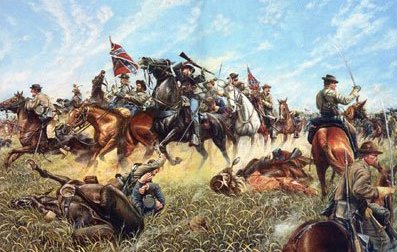 - 2nd SC Cavalry - |
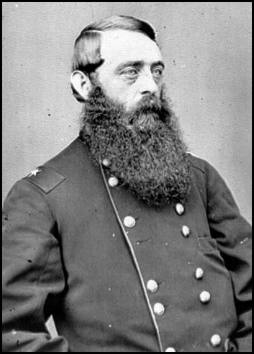
Gregg |
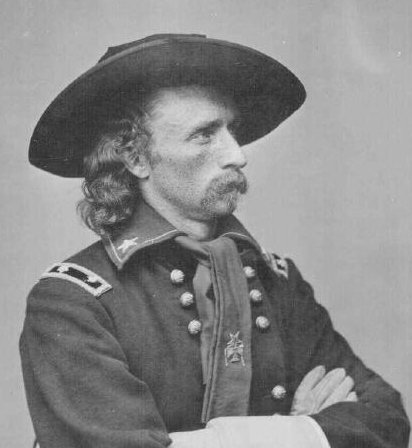
Custer |
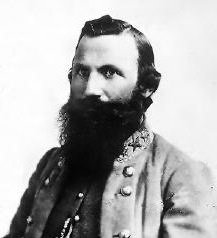
Stuart |
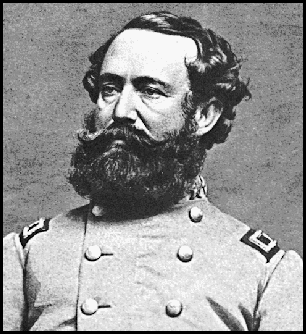
Hampton |
While Confederate artillery pounded Cemetery Ridge near Gettysburg, another drama was unfolding three miles to the east.
Union and Confederate cavalry had skirmished east of Gettysburg on July 2, and Union scouts on the Hanover Road were alert to any troop movements in that direction.
The situation appeared quiet enough to allow some Union troopers to be ordered back to the Gettysburg battlefield.
Just as the troops were about to depart, scouts spotted a cloud of dust to the north that appeared to get closer every minute.
The tramp of hundreds of horse hooves and the rumble of artillery made the Northerners realize that trouble was indeed headed their way.
It was trouble! General J.E.B. Stuart's Cavalry Division was ordered by General Lee to ride east and then south in an attempt to get into the rear of the Army of the Potomac, to disrupt and possibly cut the Union lines of communication.
Anxious to prove himself after an embarrassing confrontation with the army commander, General Stuart set out that morning to ride around the Union flank and make amends, taking it out on the Yankee army the only way he knew how: show up where the Union troops least expected him.
A true cavalier in every sense of the word, General Stuart was one of the more flamboyant horsemen in either army. Following closely behind his advance scouts, Stuart led his horsemen down unfamiliar county roads and farm lanes until they came upon a thick wood at the Rummel Farm.
South of his position, General Stuart spotted Union artillery being unlimbered on a small knoll.
Beyond the artillery rose clouds of dust and Stuart quickly realized that he had been spotted.
Ordering his artillery forward, Stuart decided to use Rummel's Woods to protect his troopers until he could determine the size of the force in his front.
Meanwhile he deployed dismounted troopers into the Rummel Farm to engage Union skirmishers already posted behind fences.
Union scouts watched as Stuart's columns rode into position and deployed in the fields around the Rummel buildings. Brig. General David McMurtie Gregg's troops had been posted on the Hanover Road until 1 P.M. when they were ordered to march to a location south of Gettysburg. Gregg was in the act of withdrawing his troops when Stuart's horsemen arrived. Gregg immediately countermanded the orders and deployed his artillery and dismounted troopers into the fields near the intersection of the Hanover Road and Low Dutch Road. Immediately a brisk fire opened between opponents. Hoping to press his advantage of surprise, General Stuart ordered his artillery to suppress the fire of the Union guns while he aligned his troops to push aside the apparently weak Union troops. But the Union response was extraordinarily accurate and the Northern artillery began to knock out the Confederate gun crews one by one.
Fighting on foot, the cavalrymen of both sides dueled in the fields of the Rummel Farm with neither side gaining any advantage. Growing frustrated at his attempts to brush aside the Union troopers, General Stuart ordered his soldiers to go forward in a mounted attack. Yet every appearance of his Confederates in the open fields was met with cannon fire and by a Union counter charge. Among Gregg's troops east of Gettysburg that afternoon was the Michigan Brigade commanded by a brash young officer named George Armstrong Custer. Custer was a newly appointed brigadier general of volunteers and Gettysburg was his first experience in command of troops in battle. Dressed in a new uniform of his own design, the fiery young officer led his troopers through the fighting and was notable for being in the forefront of the repeated Union charges over the Rummel Farm.
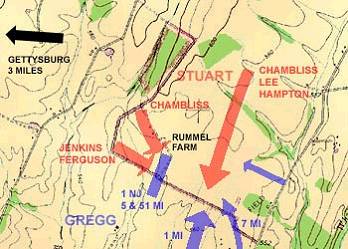
With time running out and ammunition running low among some his troopers, General Stuart wagered that one last charge using most of his force would overwhelm the Union line and hopefully scatter what appeared to be a thinly held crossroad.
He truned to his trusted cavalry brigade commaders Wade Hampton and Fitzhugh Lee for this charge. They brought all of their brigades into the field in front of Rummel Woods, their sabers and carbines glistening in the hazy sunlight.
With the command, "Battalions, forward!" the brave horsemen moved off toward the smoking Union position.
Almost immediately, Union artillery turned their guns on the massed columns, explosions striking down man and animal alike.
The veterans of Hampton's Second Carolina Cavalry were embarking on what would be the most dramatic mounted charge of the entire war.
Over the East Cavalry Field, near the Rummel Farm, the regiments of General Wade Hampton's Brigade increased their gait from a trot to a gallop in close column.
In this last desperate charge of the day, the men of the Second would put their Brigade's motto, "Honor and Immortality," to the ultimate test.
Seeing the gray column coming toward them, General Custer excitedly rode to the head of the 1st Michigan Cavalry.
With the cry, "Come on, you Wolverines!", he spurred his horse directly toward the the Confederate charge and the Union horsemen followed with sabers flashing in the afternoon sun.
The Michigan soldiers drove headlong toward Stuart's determined troopers.
The deafening roar of a thousand horses' hooves pounding over the field filled the air, as Hampton and Custer's forces raced toward each other at blinding speed.

With sabers drawn, Hampton's Brigade and the Second slammed into the First Michigan with such force that both men and horses were hurled through the air. In the melee that followed, the soldiers shot, slashed, and stabbed each other at close range. Riders were crushed amid spinning mounts, as the harsh work of the saber was dealt. Cries of the wounded and dying rose in the swirling dust of hand to hand struggle. Suddenly, a Federal force appeared on the flank of the Confederates. A battalion of Union troopers from the 3rd Pennsylvania Cavalry broke from the cover of a tree line and charged headlong into the southern rear. Attacked from three sides and nearly surrounded, there was nothing left to do but retreat.
At the close of the day, the veteran Second South Carolina Cavalry could barely field 100 riders. Although ultimately driven back by flank assaults, the men of Stuart's most elite cavalry knew they have done their duty and lived up to their reputation of "Honor and Immortality."
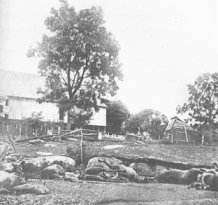
- July 1863 - |
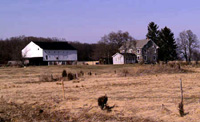
- The Rummel Farm Today - |

- The Rummel Farm battle field today -
HOME
About SCV -
Join SCV -
Legionary -
Co. News -
Chaplain -
Education
B. F. C. Site -
Ancestors -
Memorials -
Links -
Photo Gallery -
Guest Book -
Site Index